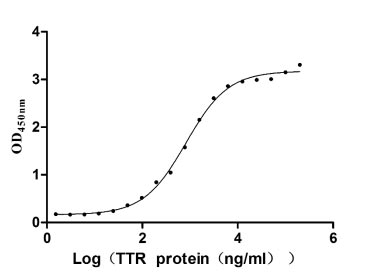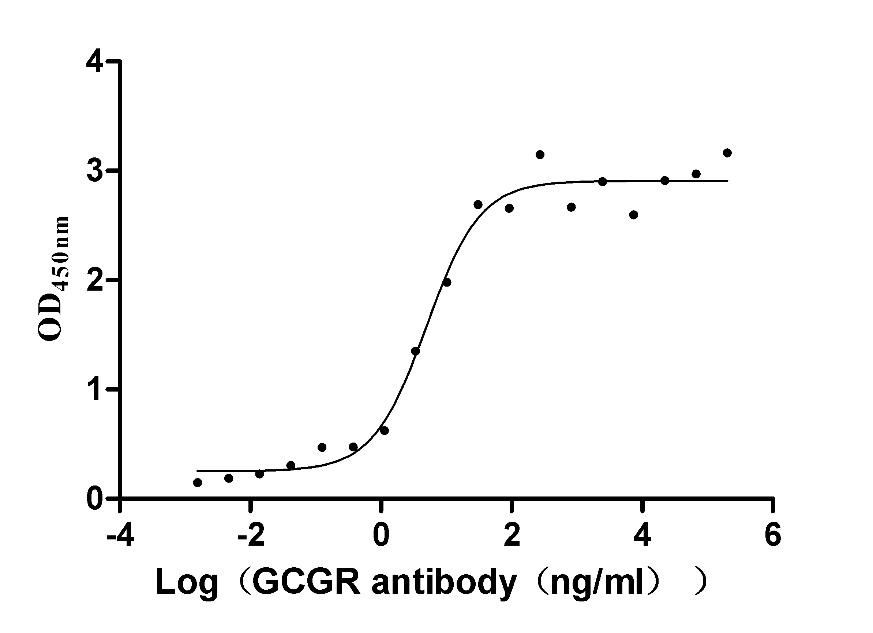Recombinant Mouse Egl nine homolog 3 (Egln3)
-
中文名称:小鼠Egln3重组蛋白
-
货号:CSB-YP849640MO
-
规格:
-
来源:Yeast
-
其他:
-
中文名称:小鼠Egln3重组蛋白
-
货号:CSB-EP849640MO
-
规格:
-
来源:E.coli
-
其他:
-
中文名称:小鼠Egln3重组蛋白
-
货号:CSB-EP849640MO-B
-
规格:
-
来源:E.coli
-
共轭:Avi-tag Biotinylated
E. coli biotin ligase (BirA) is highly specific in covalently attaching biotin to the 15 amino acid AviTag peptide. This recombinant protein was biotinylated in vivo by AviTag-BirA technology, which method is BriA catalyzes amide linkage between the biotin and the specific lysine of the AviTag.
-
其他:
-
中文名称:小鼠Egln3重组蛋白
-
货号:CSB-BP849640MO
-
规格:
-
来源:Baculovirus
-
其他:
-
中文名称:小鼠Egln3重组蛋白
-
货号:CSB-MP849640MO
-
规格:
-
来源:Mammalian cell
-
其他:
产品详情
-
纯度:>85% (SDS-PAGE)
-
基因名:
-
Uniprot No.:
-
别名:Egln3Egl nine homolog 3; EC 1.14.11.29; Hypoxia-inducible factor prolyl hydroxylase 3; HIF-PH3; HIF-prolyl hydroxylase 3; HPH-3; Prolyl hydroxylase domain-containing protein 3; PHD3; SM-20
-
种属:Mus musculus (Mouse)
-
蛋白长度:full length protein
-
表达区域:1-239
-
氨基酸序列MPLGHIMRLD LEKIALEYIV PCLHEVGFCY LDNFLGEVVG DCVLERVKQL HYNGALRDGQ LAGPRAGVSK RHLRGDQITW IGGNEEGCEA INFLLSLIDR LVLYCGSRLG KYYVKERSKA MVACYPGNGT GYVRHVDNPN GDGRCITCIY YLNKNWDAKL HGGVLRIFPE GKSFVADVEP IFDRLLFFWS DRRNPHEVQP SYATRYAMTV WYFDAEERAE AKKKFRNLTR KTESALAKD
-
蛋白标签:Tag type will be determined during the manufacturing process.
The tag type will be determined during production process. If you have specified tag type, please tell us and we will develop the specified tag preferentially. -
产品提供形式:Lyophilized powder
Note: We will preferentially ship the format that we have in stock, however, if you have any special requirement for the format, please remark your requirement when placing the order, we will prepare according to your demand. -
复溶:We recommend that this vial be briefly centrifuged prior to opening to bring the contents to the bottom. Please reconstitute protein in deionized sterile water to a concentration of 0.1-1.0 mg/mL.We recommend to add 5-50% of glycerol (final concentration) and aliquot for long-term storage at -20℃/-80℃. Our default final concentration of glycerol is 50%. Customers could use it as reference.
-
储存条件:Store at -20°C/-80°C upon receipt, aliquoting is necessary for mutiple use. Avoid repeated freeze-thaw cycles.
-
保质期:The shelf life is related to many factors, storage state, buffer ingredients, storage temperature and the stability of the protein itself.
Generally, the shelf life of liquid form is 6 months at -20°C/-80°C. The shelf life of lyophilized form is 12 months at -20°C/-80°C. -
货期:Delivery time may differ from different purchasing way or location, please kindly consult your local distributors for specific delivery time.Note: All of our proteins are default shipped with normal blue ice packs, if you request to ship with dry ice, please communicate with us in advance and extra fees will be charged.
-
注意事项:Repeated freezing and thawing is not recommended. Store working aliquots at 4°C for up to one week.
-
Datasheet :Please contact us to get it.
相关产品
靶点详情
-
功能:Prolyl hydroxylase that mediates hydroxylation of proline residues in target proteins, such as PKM, TELO2, ATF4 and HIF1A. Target proteins are preferentially recognized via a LXXLAP motif. Cellular oxygen sensor that catalyzes, under normoxic conditions, the post-translational formation of 4-hydroxyproline in hypoxia-inducible factor (HIF) alpha proteins. Hydroxylates a specific proline found in each of the oxygen-dependent degradation (ODD) domains (N-terminal, NODD, and C-terminal, CODD) of HIF1A. Also hydroxylates HIF2A. Has a preference for the CODD site for both HIF1A and HIF2A. Hydroxylation on the NODD site by EGLN3 appears to require prior hydroxylation on the CODD site. Hydroxylated HIFs are then targeted for proteasomal degradation via the von Hippel-Lindau ubiquitination complex. Under hypoxic conditions, the hydroxylation reaction is attenuated allowing HIFs to escape degradation resulting in their translocation to the nucleus, heterodimerization with HIF1B, and increased expression of hypoxy-inducible genes. ELGN3 is the most important isozyme in limiting physiological activation of HIFs (particularly HIF2A) in hypoxia. Also hydroxylates PKM in hypoxia, limiting glycolysis. Under normoxia, hydroxylates and regulates the stability of ADRB2. Regulator of cardiomyocyte and neuronal apoptosis. In cardiomyocytes, inhibits the anti-apoptotic effect of BCL2 by disrupting the BAX-BCL2 complex. In neurons, has a NGF-induced proapoptotic effect, probably through regulating CASP3 activity. Also essential for hypoxic regulation of neutrophilic inflammation. Plays a crucial role in DNA damage response (DDR) by hydroxylating TELO2, promoting its interaction with ATR which is required for activation of the ATR/CHK1/p53 pathway. Also mediates hydroxylation of ATF4, leading to decreased protein stability of ATF4.
-
基因功能参考文献:
- we identified the beta2 adrenergic receptor (ADRB2) as a downstream target for PHD3 in skeletal muscle PMID: 28939592
- PHD3 could protect against cardiac perivascular fibrosis and improve myocardial function in an obstructive sleep apnea mouse model by inhibiting endothelial-to-mesenchymal transition. PMID: 29051216
- PHD3 expression induced by cytokines is NF-kappaB dependent in mesangial cells. Endogenously produced NO further augments PHD3 expression via HIF-1 alpha. PMID: 28054119
- Opposing regulation and roles for PHD3 in lung dendritic cells and alveolar macrophages PMID: 28716863
- Our observations disclose a novel role of PHD3 in the development of Tregs. PMID: 27331863
- PHD3 is an active participant in atherogenesis PMID: 26995088
- Cardiomyocyte-specific transgenic expression of PHD3 impairs the myocardial response to ischemia. PMID: 26044310
- PHD3 protects intestinal epithelial barrier function and reveal a hydroxylase-independent function of PHD3 in stabilizing occludin PMID: 26124271
- depletion of PHD3 leads to increased stabilization of HIF-1alpha and inhibition of DNA damage response, both of which may contribute to the cardioprotective effect seen with depletion of PHD3. PMID: 25633836
- PHD3 loss sustains cell proliferation through the control of EGFR. PMID: 25420773
- Using conditional PHD3-knockout mice, it was shown that PHD3 affects the production of Angptl2 and additionally influences the response toward this apoptosis-modulating factor. PMID: 24626957
- ablation of the PHD3 gene resulted in increased angiogenesis and cardiac function after infarction thereby offering a potential target for management of ischemic myocardial disease PMID: 23978105
- isoform-specific inhibition of Phd3 could be exploited to treat type 2 diabetes without the toxicity that could occur with chronic inhibition of multiple Phd isoforms. PMID: 24037093
- Egln3 suppresses glioma progression PMID: 22905089
- mice lacking PHD3 were resistant to the effects of ionizing radiation and had decreased thymic apoptosis, a biomarker of genomic integrity PMID: 22797300
- It is concluded that impairment of PHD3 enzyme function aggravates the clinical course of abdominal sepsis PMID: 22786772
- PHD3 has a role in regulating neutrophil survival in hypoxia PMID: 21317538
- EGLN3 has a role in the regulation of NF-kappaB and suggests that it is involved in mediating myogenic differentiation, which is HIF-independent PMID: 20089853
- PHD3 appears to be a tumor suppressor in colorectal cancer cells that inhibits IKKbeta/NF-kappaB signaling, independent of its hydroxylase activity. PMID: 19786027
- Egln1/2/3 play dual roles in chondrocyted growth, acting as oxygen sensors and mediators of late stage events in the cell cycle. PMID: 17044072
- the role of PHD3 in sympathoadrenal development extends beyond simple control of cell survival and organ mass, with functional PHD3 being required for proper anatomical and physiological integrity of the system PMID: 18332118
- Phd3 loss exacerbates the HIF activation, hepatic steatosis, dilated cardiomyopathy, and premature mortality. PMID: 19720742
显示更多
收起更多
-
亚细胞定位:Nucleus. Cytoplasm.
-
组织特异性:Highly expressed in cardiac and smooth muscle. Also high expression in brain, skeletal muscle and kidney. Low levels in lung.
-
数据库链接:
KEGG: mmu:112407
STRING: 10090.ENSMUSP00000041874
UniGene: Mm.133037
Most popular with customers
-
Recombinant Human Retinol-binding protein 4 (RBP4) (Active)
Express system: Mammalian cell
Species: Homo sapiens (Human)
-
Recombinant Human Glucagon receptor (GCGR), partial (Active)
Express system: Mammalian cell
Species: Homo sapiens (Human)
-
Recombinant Human Complement component C1q receptor (CD93), partial (Active)
Express system: Mammalian cell
Species: Homo sapiens (Human)
-
Recombinant Human Myosin regulatory light polypeptide 9 (MYL9) (Active)
Express system: Yeast
Species: Homo sapiens (Human)
-
Recombinant Human Gastric inhibitory polypeptide receptor(GIPR),partial (Active)
Express system: Mammalian cell
Species: Homo sapiens (Human)

















